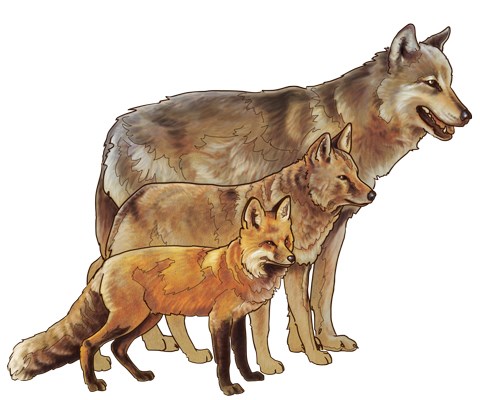
NPS/Neal Herbert Coyotes (Canis latrans) are intelligent and adaptable. They can be found throughout North and Central America, thriving in major urban areas as well as in remote wilderness. This adaptability helped coyotes resist widespread efforts early in the 1900s to exterminate them in the West, including Yellowstone National Park, where other mid-size and large carnivores such as cougars and wolves were eradicated. The coyote is a common predator in Greater Yellowstone, often seen traveling through open meadows and valleys. 
Number in YellowstoneAbundant Where to SeeMeadows, fields, other grasslands, and foraging for small mammals along roadways. Size and Behavior
History

DescriptionOften mistaken for a wolf, the coyote is about one-third the wolf’s size with a slighter build. Its coat colors range from tan to buff, sometimes gray, and with some orange on its tail and ears. Males are slightly larger than females. During the 1900s, coyotes partially filled the niche left vacant after wolves were exterminated from the park. In Yellowstone, they lived in packs or family groups of up to seven animals. This social organization is characteristic of coyotes living in areas free from human hunting. With the reintroduction of wolves, Yellowstone coyotes have returned to a more typical social organization—pairs with pups. Coyotes, also known as “song dogs,” communicate with each other by a variety of long-range vocalizations. You may hear groups or lone animals howling, especially during dawn and dusk periods. Coyotes also mark with their scent (urine and feces) to communicate their location, breeding status, and territorial boundaries. PopulationUntil 1995, coyotes faced few predators in Yellowstone other than cougars, who will kill coyotes feeding on cougar kills. After wolves were restored, however, dozens of coyote pups and adults were killed by wolves—primarily when feeding on other animals killed by wolves. After wolves were restored on the northern range, the coyote population decreased by as much as 50% as a result of competition for food, attacks by wolves, and loss of territory to wolves.More recent trends in the Lamar Valley, however, indicate that the coyote population has increased. Comparisons of coyote population and behavioral data from before and after wolf restoration provide evidence of how the presence of wolves is changing ecological relationships on the northern range. A reduced coyote population could mean that smaller predators such as the native red fox, whose numbers were previously kept low by coyotes, will have less competition for small prey and their populations may increase. While this relationship is yet to be evaluated critically, recent data from remote camera studies in the park show that coyotes and red foxes have opposite peaks and lulls in their daily activity patterns in winter months. This suggests some level of temporal avoidance is occurring, despite their ubiquitous occupancy of similar habitats. Furthermore, data suggests movement patterns and habitat use overlaps with top predators like wolves and cougars in a way that balances the risks and rewards of scavenging from predator kills given that these smaller canids are sometimes killed by the larger carnivores. Coyotes and HumansCoyotes also face threats from humans. They quickly learn habits like roadside feeding. This may lead to aggressive behavior toward humans and can increase the risk of the coyote being hit by a vehicle. Several instances of coyote aggression toward humans, including a few attacks, have occurred in Yellowstone. Park staff scare coyotes away from visitor-use areas and prevent them from becoming habituated to humans by hazing with cracker-shell rounds, bear pepper spray, or other negative stimuli. Animals that continue to pose a threat to human safety or property are killed.

Mammals
Home to the largest concentration of mammals in the lower 48 states. ResourcesCrabtree, R.L., and J.W. Sheldon. 1999. The ecological role of coyotes on Yellowstone’s northern range. Yellowstone Science 7:15–23. Crabtree, R.L., and J.W. Sheldon. 1999. Coyotes and canid coexistence in Yellowstone. Pages 126–163 in T. W. Clark, et al, editors. Carnivores in Ecosystems: the Yellowstone Experience. New Haven: Yale University Press. Gese, E.M. 1999. Threat of predation: do ungulates behave aggressively towards different members of a coyote pack? Can. J. Zool. 77:499–503. Gese, E.M. et al. 1996. Foraging ecology of coyotes: the influence of extrinsic factors and a dominance hierarchy. Can. J. Zool. 74:769–783. Gese, E.M. et al. 1996. Social and nutritional factors influencing dispersal of resident coyotes. Anim. Behav. 52:1025–1043. Gese, E.M. and R.L. Ruff. 1997. Scent-marking by coyotes: the influence of social and ecological factors. Anim. Behav. 54:1155–1166. Gese, E.M. and R.L. Ruff. 1998. Howling by coyotes: variation among social classes, seasons, and pack sizes. Can. J. Zool. 76: 1037–1043. Gese, E.M., T.E. Stotts, and S. Grothe. 1996. Interactions between coyotes and red foxes in Yellowstone National Park, Wyoming. Journal of Mammalogy 77(2):377–382. Gese, E.M., R.L. Ruff, and R.L. Crabtree. 1996. Intrinsic and extrinsic factors influencing coyote predation of small mammals in Yellowstone National Park. Canadian Journal of Zoology 74(5):784–797. Moorcroft, P.,M. A. Lewis, and R.L. Crabtree. 1999. Home range analysis using a mechanistic home range model. Ecology 80:1656–1665. Moorcroft, P.R., M.A. Lewis, and R.L. Crabtree. 2006. Mechanistic home range models capture spatial pat- terns and dynamics of coyote territories in Yellowstone. Proceedings of the Royal Society Biological Sciences 273:1651–1659. |
Last updated: April 18, 2025
